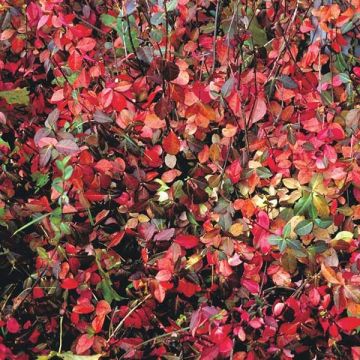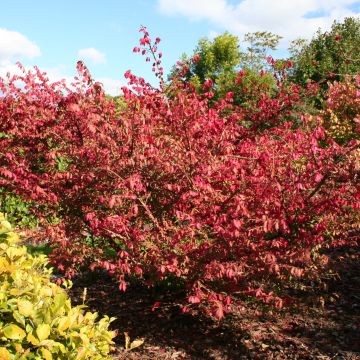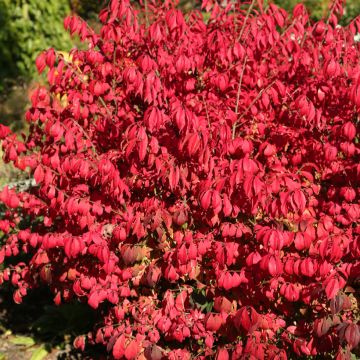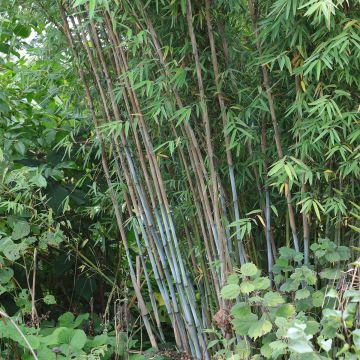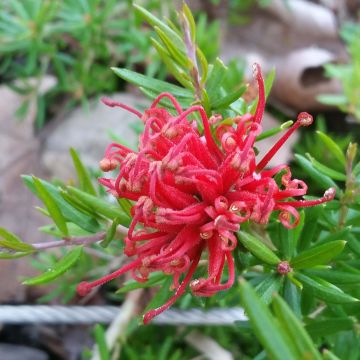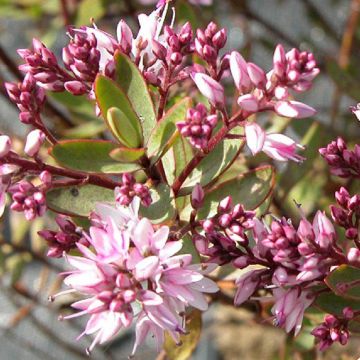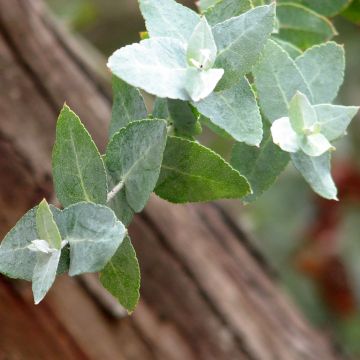Shipping country and language
Your country of residence may be:
Your country of residence is:
For a better user experience on our website, you can select:
Your shipping country:
Andorra
Austria
Belgium
Bulgaria
Canada
Chile
Croatia
Cyprus
Czechia
Denmark
Estonia
Finland
France
Germany
Greece
Hungary
Iceland
Ireland
Italy
Latvia
Lithuania
Luxembourg
Malta
Monaco
Netherlands
Poland
Portugal
Romania
Slovakia
Slovenia
Spain
Sweden
Switzerland
United Kingdom
We only deliver seed and bulb products to your country. If you add other products to your basket, they cannot be shipped.
Language:
French
German
Spanish
English
My Account
Hello
My wish lists
Plantfit
Log in / Register
Existing customer?
New customer?
Create an account to track your orders, access our customer service and, if you wish, make the most of our upcoming offers.


Euonymus japonicus Aureus - Japanese Spindle


Euonymus japonicus Aureus - Japanese Spindle
Euonymus japonicus Aureus - Japanese Spindle
Euonymus japonicus Aureus
Japanese Spindle, Evergreen Spindle
Beautiful plant but one arrived in average condition and died a few months later. The second one is doing very well.
Laetitia , 15/04/2024
Order in the next for dispatch today!
Dispatch by letter from €3.90.
Delivery charge from €5.90 Oversize package delivery charge from €6.90.
More information
This item is not available in your country.
Schedule delivery date,
and select date in basket
This plant carries a 24 months recovery warranty
More information
We guarantee the quality of our plants for a full growing cycle, and will replace at our expense any plant that fails to recover under normal climatic and planting conditions.
From €5.90 for pickup delivery and €6.90 for home delivery
Express home delivery from €8.90.
From €5.90 for pickup delivery and €6.90 for home delivery
Express home delivery from €8.90.

Does this plant fit my garden?
Set up your Plantfit profile →
Description
The Euonymus japonicus Aureus is a particularly bright and colourful variety of Japanese Spindle, with beautiful evergreen foliage that is cream-yellow, strongly margined with green throughout the year, even in winter. It allows for the creation of dense and vibrant evergreen hedges and elegant topiaries for the terrace. This bush can be grown in full sun or partial shade, in ordinary, moist soil, even chalk.
The Japanese Spindle belongs to the Celastraceae family. As its name suggests, it is native to Japan, but it can also be found in China and Korea. In the wild, this large bush grows on slopes, in open areas on the edge of forests, and even by the sea where it can reach a height of 8m (26.2ft) and become a tree. It is hardy to about -12°C (10.4°F) and its growth rate is quite slow.
The 'Aureus' cultivar, with a more compact growth habit, is also distinguished by its variegated foliage of yellow and green, with the variegation inverted in comparison to the 'Aureomarginatus' variety. In our gardens, it will reach an average height of 2m (6.6ft) with a spread of 1.50m (3.3ft), and even more if not regularly pruned. Its habit is naturally bushy and rather upright. Well-branched from the base, its upright branches bear dense foliage composed of glossy leaves that are yellow in the centre of the irregularly green-bordered surface. They are oval-shaped, measuring 3 to 5cm (2in) in length, with finely dentate margins. The inconspicuous flowering occurs in May-June at the tips of the young shoots. Tiny white-greenish flowers with 4 petals are clustered together. They are pollinated by insects and are followed by the formation of small green fruits that turn pink and orange in autumn, hanging under the branches.
The Euonymus japonicus Aureus, traditionally used to create medium-sized evergreen hedges, can also be used in shrub borders to create contrasts with dark Physocarpus, barberries, or even bush or groundcover roses. Its variegated foliage compliments all types of flowering plants and works well in partially shaded areas of the garden. Well-suited to coastal areas and urban gardens, the Japanese Spindle is often used to create hedges along pathways or property boundaries to protect against wind and prying eyes. It adapts well to container gardening, which can be placed on the terrace or balcony, and it responds well to pruning. Its height will be less significant in pots, allowing the gardener to experiment with topiary art.
Tip: In case of drought, water to maintain beautiful foliage.
Euonymus japonicus Aureus - Japanese Spindle in pictures


Plant habit
Flowering
Foliage
Botanical data
Euonymus
japonicus
Aureus
Celastraceae
Japanese Spindle, Evergreen Spindle
Cultivar or hybrid
Other Japanese Spindle Trees - Euonymus japonicus
Planting and care
The Euonymus japonicus is best planted in spring in any well-drained soil in a partly sunny or lightly shaded location. It prefers deep soils, rich in humus, that remain moisture, and tolerates the presence of chalk. It is hardy down to approximately -12/-14°C (10.4/6.8F). Very comfortable on the coast, climates that are too hot and too dry are not suitable for this evergreen spindle tree, as there is a risk of it being invaded by mealybugs and sooty mould. Pruning is best between April and May. Attention: pruning too early in spring can be harmful to the young tender shoots in case of late frosts. Likewise, frequent pruning can lead to the development of sooty mould, especially in very dry soil. Apply fertilizer twice a year, in early spring and autumn. In case of drought, water to maintain beautiful foliage. If the plant is grown in a pot, it is necessary to change the growing medium once a year in spring. Protect your pot if strong frosts are forecast (<-5°C (23°F).
Planting period
Intended location
Care
- , onOrder confirmed
Reply from on Promesse de fleurs
Evergreen shrubs
Haven't found what you were looking for?
Hardiness is the lowest winter temperature a plant can endure without suffering serious damage or even dying. However, hardiness is affected by location (a sheltered area, such as a patio), protection (winter cover) and soil type (hardiness is improved by well-drained soil).

Photo Sharing Terms & Conditions
In order to encourage gardeners to interact and share their experiences, Promesse de fleurs offers various media enabling content to be uploaded onto its Site - in particular via the ‘Photo sharing’ module.
The User agrees to refrain from:
- Posting any content that is illegal, prejudicial, insulting, racist, inciteful to hatred, revisionist, contrary to public decency, that infringes on privacy or on the privacy rights of third parties, in particular the publicity rights of persons and goods, intellectual property rights, or the right to privacy.
- Submitting content on behalf of a third party;
- Impersonate the identity of a third party and/or publish any personal information about a third party;
In general, the User undertakes to refrain from any unethical behaviour.
All Content (in particular text, comments, files, images, photos, videos, creative works, etc.), which may be subject to property or intellectual property rights, image or other private rights, shall remain the property of the User, subject to the limited rights granted by the terms of the licence granted by Promesse de fleurs as stated below. Users are at liberty to publish or not to publish such Content on the Site, notably via the ‘Photo Sharing’ facility, and accept that this Content shall be made public and freely accessible, notably on the Internet.
Users further acknowledge, undertake to have ,and guarantee that they hold all necessary rights and permissions to publish such material on the Site, in particular with regard to the legislation in force pertaining to any privacy, property, intellectual property, image, or contractual rights, or rights of any other nature. By publishing such Content on the Site, Users acknowledge accepting full liability as publishers of the Content within the meaning of the law, and grant Promesse de fleurs, free of charge, an inclusive, worldwide licence for the said Content for the entire duration of its publication, including all reproduction, representation, up/downloading, displaying, performing, transmission, and storage rights.
Users also grant permission for their name to be linked to the Content and accept that this link may not always be made available.
By engaging in posting material, Users consent to their Content becoming automatically accessible on the Internet, in particular on other sites and/or blogs and/or web pages of the Promesse de fleurs site, including in particular social pages and the Promesse de fleurs catalogue.
Users may secure the removal of entrusted content free of charge by issuing a simple request via our contact form.
The flowering period indicated on our website applies to countries and regions located in USDA zone 8 (France, the United Kingdom, Ireland, the Netherlands, etc.)
It will vary according to where you live:
- In zones 9 to 10 (Italy, Spain, Greece, etc.), flowering will occur about 2 to 4 weeks earlier.
- In zones 6 to 7 (Germany, Poland, Slovenia, and lower mountainous regions), flowering will be delayed by 2 to 3 weeks.
- In zone 5 (Central Europe, Scandinavia), blooming will be delayed by 3 to 5 weeks.
In temperate climates, pruning of spring-flowering shrubs (forsythia, spireas, etc.) should be done just after flowering.
Pruning of summer-flowering shrubs (Indian Lilac, Perovskia, etc.) can be done in winter or spring.
In cold regions as well as with frost-sensitive plants, avoid pruning too early when severe frosts may still occur.
The planting period indicated on our website applies to countries and regions located in USDA zone 8 (France, United Kingdom, Ireland, Netherlands).
It will vary according to where you live:
- In Mediterranean zones (Marseille, Madrid, Milan, etc.), autumn and winter are the best planting periods.
- In continental zones (Strasbourg, Munich, Vienna, etc.), delay planting by 2 to 3 weeks in spring and bring it forward by 2 to 4 weeks in autumn.
- In mountainous regions (the Alps, Pyrenees, Carpathians, etc.), it is best to plant in late spring (May-June) or late summer (August-September).
The harvesting period indicated on our website applies to countries and regions in USDA zone 8 (France, England, Ireland, the Netherlands).
In colder areas (Scandinavia, Poland, Austria...) fruit and vegetable harvests are likely to be delayed by 3-4 weeks.
In warmer areas (Italy, Spain, Greece, etc.), harvesting will probably take place earlier, depending on weather conditions.
The sowing periods indicated on our website apply to countries and regions within USDA Zone 8 (France, UK, Ireland, Netherlands).
In colder areas (Scandinavia, Poland, Austria...), delay any outdoor sowing by 3-4 weeks, or sow under glass.
In warmer climes (Italy, Spain, Greece, etc.), bring outdoor sowing forward by a few weeks.

